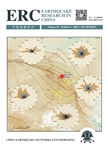Towards fast focal mechanism inversion of shallow crustal earthquakes in the Chinese mainland
作者机构:China Earthquake Networks CenterBeijing100045China
出 版 物:《Earthquake Research Advances》 (地震研究进展(英文))
年 卷 期:2024年第4卷第2期
页 面:36-44页
核心收录:
学科分类:070801[理学-固体地球物理学] 07[理学] 0708[理学-地球物理学]
基 金:sponsored by the China Spark Program of Earthquake Science and Technology(XH23051B)
主 题:Automatic focal mechanism solution Chinese mainland Moment magnitude Centroid depth
摘 要:We have developed an automatic regional focal mechanism inversion system based on the Earthquake Rapid Report(ERR) system and the real-time three-component seismic waveform stream of 1 000 broadband seismic stations provided by the China Earthquake Networks Center(CENC). The system can rapidly provide a double couple solution and centroid depth within 5–15 min after receiving earthquake information from the ERR *** data processing is triggered by earthquake information obtained from the ERR system. The system is capable of determining the focal mechanism of all shallow-depth earthquakes in the Chinese mainland with a magnitude of 5.5–6.5. It utilizes waveform data recorded by seismic stations located within 500 km from the epicenter,enabling the reporting of a focal mechanism solution within 5–15 min of an earthquake occurrence. Additionally,the system can assign a corresponding grade(A B C) to the focal mechanism solution. We processed a total of 301earthquakes that occurred from 2021 to June 2022, and after the quality control, 166 of them were *** selected solutions were manually checked, and 160 of them were compiled in a focal mechanism *** catalog can be conveniently downloaded online via the Internet. The automatic focal mechanism solution of earthquakes in eastern China exhibits a good agreement with that provided by the Global Centroid Moment Tensor(GCMT), when available. The average Kagan angle between this catalog and GCMT is 22°, and the average difference in MWis 0.17. Furthermore, compared with GCMT, the minimum magnitude of our catalog has been reduced from approximately 5.0 to 4.0. The correlation between the centroid depth and crustal thickness in the Chinese mainland confirms the distribution of the centroid depth.



